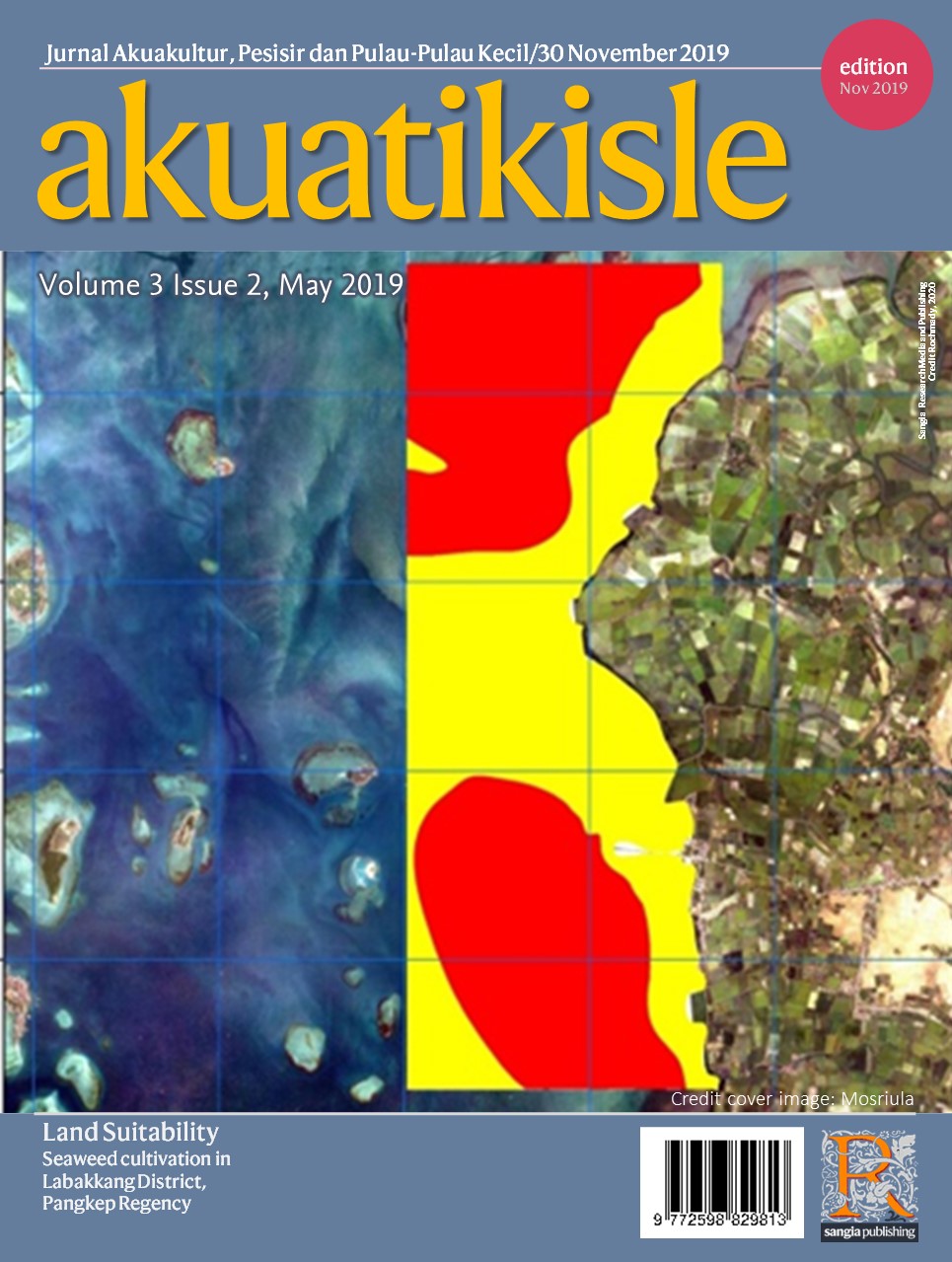Akuatikisle: Jurnal Akuakultur, Pesisir dan Pulau-Pulau Kecil
Full Length Article
Growth and exploitation status of indian catfish Plotosus canius in waters of Tanjungpinang City, Riau Islands
Pertumbuhan dan status eksploitasi ikan sembilang (Plotosus canius) di perairan Kota Tanjung Pinang, Kepulauan Riau, Indonesia
Highlights
Generate NLP AI by Wizdam ID.
Abstract
Penelitian mengenai pertumbuhan dan status eksploitasi ikan sembilang (Plotosus canius) penting dalam menunjang pengelolaan sumberdaya ikan di Perairan Kota Tanjungpinang, Kepulauan Riau. Penelitian bertujuan untuk mengetahui pola pertumbuhan, parameter pertumbuhan, dan status eksploitasi ikan sembilang di Perairan Kota Tanjungpinang, Provinsi Kepulauan Riau. Penelitian dilakukan dengan metode purposive sampling sebanyak 3 stasiun dengan jumlah sampel yaitu 529 individu. Analisis data pertumbuhan dan status eksploitasi menggunakan software FISAT II dan analisis regresi menggunakan Excel 2017. Pola hubungan panjang-bobot ikan sembilang betina dan jantan adalah allometrik negatif (pertambahan panjang lebih cepat daripada pertambahan bobot). Status eksploitasi ikan sembilang paling tinggi sebesar 0.73 per tahun. Nilai eksploitasi telah melebihi nilai eksploitasi optimum 0,5.
Abstract
Research on the growth and exploitation status of indian catfish (Plotosus canius) is important in supporting the management of fish resources in the waters of Tanjungpinang City, Riau Islands. The study aims to determine the pattern of growth, growth parameters, and the status of indian catfish exploitation in the waters of Tanjungpinang City, Riau Islands Province. The study was conducted with a purposive sampling method of 3 stations with a total sample of 529 individual fish crosses. Analysis of growth and exploitation status data using FISAT II software and regression analysis using Excel 2017. This study resulted in a pattern of long relations and the weight of fish as a female and males both are negative allometric (faster increase in length than weight increase). The highest rate of exploitation of indian catfish is obtained from the data of 0.73 per year. This exploit value exceeds the optimum exploitation value of 0.5.
Keywords
Introduction
Section snippets
Material and Methods
Materials and methods from the full-text PDF of this article cannot be displayed.
Results
Results from the full-text PDF of this article cannot be displayed.
Discussion
Discussion from the full-text PDF of this article cannot be displayed.
Conclusions
Conclusions from the full-text PDF of this article cannot be displayed.
Acknowledgment
Acknowledgment from the full-text PDF of this article cannot be displayed.
Competing interest
The authors declare that they have no known competing financial interests or personal relationships that could have appeared to influence the work reported in this paper.
Conflict of interest
The authors declare that the research was conducted in the absence of any commercial or financial relationships that could be construed as a potential conflict of interest.
Ethical approval acknowledgements
No ethical approval required for this article. All procedures followed were in accordance with the ethical standards of the responsible committee on human experimentation (institutional and national) and with the Helsinki Declaration of 1975, as revised in 2008 (5)
Supplementary files
Data sharing not applicable to this article as no datasets were generated or analysed during the current study, and/or contains supplementary material, which is available to authorized users.
Bibliographic Information
Cite this article as:
-
Submitted
29 July 2019 -
Revised
9 October 2019 -
Accepted
8 November 2019 -
Published
21 November 2019 -
Version of record
25 December 2019 -
Issue date
30 November 2019
-
Academic subject
Life Science; Fisheries Sciences
Copyright
Copyright © 2019 Rouli Verawati Gurning, Susiana Susiana, Ani Suryanti. Sangia Research Media and Publishing. Production and hosting by Sangia (SRM™).  This work is licensed under a Creative Commons Attribution-ShareAlike 4.0 International License.
This work is licensed under a Creative Commons Attribution-ShareAlike 4.0 International License.
Disclaimer: All claims expressed in this article are solely those of the authors and do not necessarily represent those of their affiliated organizations, or those of the publisher, the editors and the reviewers. Any product that may be evaluated in this article or claim that may be made by its manufacturer is not guaranteed or endorsed by the publisher.
Comments on this article
By submitting a comment you agree to abide by our Terms and Community Guidelines. If you find something abusive or that does not comply with our terms or guidelines please flag it as inappropriate.



